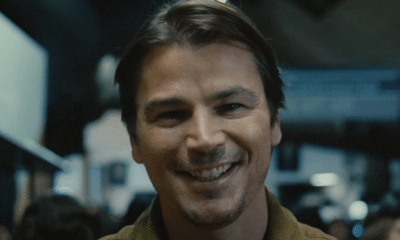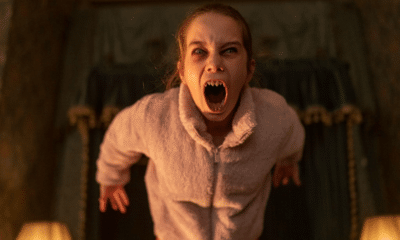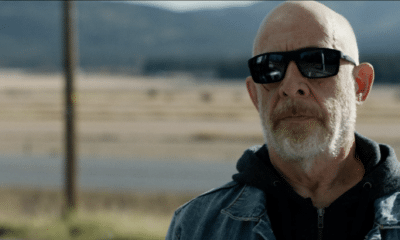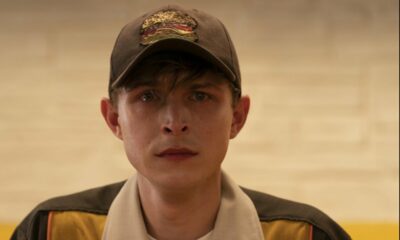Gangs of London has been a shining beacon during our lockdown. The ten episode series arrived on Sky Atlantic in March and gave us all something to distract us from the world outside. Set in London, the crime action thriller followed the aftermath of the death of criminal kingpin Finn Wallace. His son Sean takes over the ‘kingdom’, but fractures between factions soon make themselves evident and all manners of Hell break loose. Add to that an undercover police officer out to dismantle the hierarchy from within, and you have all the ingredients for a stellar drama.
The most explosive part of the programme is the action design and stunt performances. Each episode is chopped full of electric fights, gun sieges, axe battles and so much more. No surprise really given that Gareth Evans, the mastermind behind the The Raid films, is one of the show’s creators. Helping Evans out with the action design is Jude Poyer. Poyer, a London native, has worked professionally as a stuntman for more than two decades, eight years of which had him based in Hong Kong. During this time he was fortunate enough to work with stars including Jackie Chan, Jet Li, Sammo Hung, and Jean Claude Van Damme, as well as respected directors including Tsui Hark, Andrew Lau, and Tarsem Singh.
To coincide with the home entertainment release of Gangs of London, we sat down with Poyer to get some insight into just what exactly went into making that on-screen magic. Be warned, the following contains spoilers of events from the series.

What made you decide that you wanted to work in film?
I guess the short version is I grew up loving films. From a very small age, action movies – James Bond, Jaws, Indiana Jones, Star Wars – that sort of thing. Then, when I was about eight years old, I discovered martial arts films and martial arts. I was studying martial arts and watching a lot of action and martial arts movies from Asia. Then when I was eighteen, I decided to go to Hong Kong and try and work in the Hong Kong film industry. I was watching a lot of Hong Kong films and seeing Westerners popping up in those movies, playing usually bad guys, having fights with the heroes and the heroines, and because I knew I wanted to work in the film industry I thought instead of perhaps going to film school or something, I would try and learn on the job out in Hong Kong.
Was it always stunt work that attracted you?
I liked acting and I liked performing, so when I first went out there I was probably more interested in the action-actor route. But once I was there and I was working with stunt people, and then playing these characters performing stunts, I found that actually I’m not a good actor – I’m probably not even a good stuntman – but I found stunt-work more appealing and interesting. That’s something I find now, not just performing stunts, but these days it’s the idea of choreographing and designing action sequences that I find most interesting.

You’ve been able to work with a lot of big names in front of, and behind the camera. Would you say that there is anyone from whom you’ve learned a lot from?
I have been very lucky to work with a lot of the people I admire and consider some of the best in the world. In front of the camera you’re talking about Jet Li, Jackie Chan, people like that. Then behind the camera it was the action coordinators and action directors. I wouldn’t say there was one particular person that taught me a lot, but being on set and observing them taught me an awful lot about action film-making. That, and then also watching their work. Even now I still watch a lot of the Hong Kong films from the eighties and nineties because a lot of the time those action sequences hold up a lot better than films from the last decade.
If I had to pick one Hong Kong action director whose style I admire the most, it would be Sammo Hung. He’s like Jackie Chan’s older brother, they grew up together. Sammo is very good at whether he’s doing a historical Kung-fu film, or a modern day cop film; his action always feels like a fight. He’s very good and selective about his use of camera placement and editing. That’s something that’s had a huge influence on me, and certainly carries over into Gangs of London. Whenever I’m working with Gareth our remit is – it needs to feel like a fight. I’m not saying realistic, because what we do isn’t realistic. But hopefully for the audience, once they’re in that world of the story, and Gangs of London isn’t meant to be documentary real, it’s a heightened London. We want the action sequences to feel emotionally like they are actual fights and that there is consequence, and there is risk of injury, and a risk of death. As a contrast to that, if you look at Jackie Chan – who is a huge influence on me., his fights often don’t feel as much fights as Sammo Hung’s because there’s a more playful dance-like enjoyable quality to them. They’re a bit more knockabout.
You worked with Gareth Evans on Apostle, is that how you got involved in Gangs of London?
Gareth’s a big Hong Kong fan, and I believe that Apostle is the first thing he did back in the UK. I think he wanted to make sure – even though it wasn’t an action film – he wanted to make sure that certain action beats and fight moments landed, and that he was working with someone who understood the style and influences that he has. I was asked to do Apostle and we worked well and very comfortably together on that. Fast forward a year and a half or so and he asked me to do Gangs.

You worked across the entire series, did you find that the different directors wanted different things from their action sequences?
Not so much, because Gareth directed action sequences in other episodes, not just the ones he directed. Gareth directed episodes one and episode five – the one in Wales – but he also directed major set pieces in two and three. For instance, episode two is Corin [Hardy]’s episode but it begins with a sequence in Turkey where a truck full of cows is blown up – that was directed by Gareth. Then the massacre where the Wallace gang attack the camp site at the end of two is also Gareth. Obviously I worked very closely with Gareth on those sequences. Same thing with episode three, the axe and knife fight in the apartment, that’s all Gareth.
What I found with Xavier [Gens], because I didn’t work with Corin too much, but with Xavier it was a case of collaborating on some smaller moments. Xavier is very much about character and motivation and emotion. In episode nine for instance, there’s Luan Dushaj, the Albanian gangster, he is about to be killed by the Nigerian gang in a hotel room. That was something where Xavier said to me, ‘I think you should direct the actual fight sequence on second unit’ So prior to filming the fight we discussed ideas, and he talked about where the character’s mental state was, what the character’s emotional state was, and then I fed that into the choreography and the shooting style. That’s actually a very Hong Kong way of working, where you have a director working with an action director who’s a stunt person, then hopefully if it works well, it doesn’t feel like a schizophrenic product. It should flow, and people shouldn’t feel that there are two directors at work.
That is a very emotional scene, there’s this guy that’s desperate to for his family to live and he takes down a room full of machete wielding maniacs.
That’s it. And what Xavier said to me is that he wanted to feel the animal come out of Luan at that moment. It had to feel very wild, and for all kinds of reasons – we had under a day to shoot that fight – but I wanted that fight to be over very quickly. If you do a sustained intricately choreographed fight, where one man is fighting four / five armed attackers, very quickly it can feel like a choreographed set piece. It stretches the credibility with the audience, and I think in that moment it would have been wrong to do some ambitious choreographed set piece. It needed to be something where people’s lives are being taken very quickly and Luan’s adrenaline is getting him through it.
That definitely comes across.
I found Xavier was very open to ideas, like the camera being outside in the corridor and just seeing the machete blade burst through. That’s not stunt-work per say, it’s action design. That’s what we tried to do with Gangs of London. With a lot of British TV shows you have stunt people who just do the choreography. They’re often left out of the bigger picture in terms of how the sequences should flow and feel, and what I loved about Gangs is it felt like something new for British television. In that, the action team were very much a part of the bigger conversations about characters, about tone, about sequences. It’s the norm in Asia for stunt people or action directors to have a lot of input, and America’s going that way as well, but I think Britain has got a lot of catching up to do. There’s that show Into the Badlands which was I think they shot two seasons in Ireland. They had full time action units going on that show. That sort of thing doesn’t happen in the UK normally. Gangs is kind of a first for that. I think people are sensing that and they watched it, and it didn’t feel like your typical fight sequences. There’s been a lot of thought and design put into it. Not just between the director and the stunt department, but the visual effects, the special effects, the costume people. They’re all part of the conversation.
We did a lot of work on the bigger sequences in pre-production. Very rarely did we just turn up on the set and make something up. My stunt team, Gareth and I and Matt Flannery did three months of action design before photography started. We would be in a training hall and we would build sets out of cardboard boxes. We’d do the choreography and then Gareth would shoot the pre-vis. We’d try different things, but ultimately when we came to shooting we’re following this pre-vis that Gareth has made shot-for-shot, edit-to-edit. That’s why I think with Gareth’s work it’s very specific. You don’t feel that there’s just a bunch of cameras pointed at some stuff. Then because we have a video storyboard, we’re able to show that ahead of time to the special effects people, and to the art department and we can say, ‘we need these props built out of rubber,’ etc. so those things can be implemented.

The hard work certainly pays off, it feels much more like you’re watching a series of feature films rather than a television show.
I think that’s definitely what they hoped for. I think all heads of departments wanted to work at a high standard that wouldn’t look out of place on a feature film. That includes the art department, the costume, the hair and make-up. The show feels very designed, which I think you often don’t get in British television.
A hard question I know, given how many stunning sequences there are in the show, but are there any moments that you’re particularly proud of helping create?
I’m really happy with episode five as a whole. When I say as a whole, I don’t just mean from a stunt coordinator perspective, but I think Gareth made a fifty minute action movie. The first half of it is action free and it’s about building up tension, and it’s a slow burn. It’s about the journey this character Kinney, who initially from the first two episodes we probably don’t like very much goes on. Then the second half is action of a very high standard, but I think the reason why the action works is because of the build up Gareth has done prior to that in terms of spending time with these different characters. I am happy with the action because I think we did some really ambitious things that probably haven’t been seen on television before. That’s not just down to stunt department, that’s down to a lot of crew members putting their heads together and coming up with solutions for how we achieve certain actions. So I’m very happy with that episode. I remember when I first joined the show and I read episode five, knowing that Gareth was going to direct that, I was very, very excited. Obviously on the page, the action beats won’t be completely spelled out because a lot of that comes out of action design and choreography. But the bones, the skeleton, was there. I just knew Gareth directing that – because I really do think that Gareth isn’t just a master of action, I think he’s a master of tension – I was excited. I’m really happy with how people are receiving it. You see on Twitter and so on that people are going nuts for episode five. Often in TV Shows you get to the middle of the season and there’s a bit of a lull. Sometimes you get the red herring unusual episode, and sometimes you feel that that’s a bit of a cop out. That’s the one where they didn’t want to spend the money. Well it was the opposite here.
Apart from episode five I’m really happy with the fight sequence at the end of episode three. Which is where Sope [Dirisu] is fighting a character called Cole played by Gordon Alexander, who is a very good stuntman and actor that I was able to introduce to the project. That for me is a special fight because it’s very rare that in the UK as a fight choreographer you get to indulge yourself quite so much. Whilst I don’t see it as a Kung-fu fight let’s say, but it is quite technical in places. We got to play with different techniques. I got to, with my team, play with different ideas. Like using an axe in a small space, a long range weapon in a bathroom, but then the fight breaks out into the bigger apartment, and then it’s using knives. So a short range weapon in a larger space. So just playing with different things. One thing I love to do is play with audience expectations. Really when it comes to choreography; punches, kicks, blocks, they’ve all been done before in one way or another. It’s how you present it that should be fresh and interesting to the audience. Choreography and performance is at most fifty percent of a successful fight sequence. It lives and dies by the camera and editing, and I think both Gareth and Matt Flannery, his DP, did a brilliant job of lensing that fight and also with the rhythms of how it was cut together. I’m happy with that fight, and even though it is very choreographed, I think it still feels like a fight. When you’re able to put things in there like Gordon stamping on Elliott, which was pretty brutal, it felt different compared to most of the fights that I’ve been able to do in the UK.
I was pushing for Gordon to play the role because Gareth had said he thought a stuntman could play the role. That’s one of the things that is great about Gareth, he’s open to stunt performers or actors playing featured roles. We would not have been able to have that fight if it were actor versus actor. We would have had to shoot it very differently because we would have hid stunt doubles and so on. We actually used Gordon to shoot our pre-vis and then Gareth showing his face – it’s often times if you’re showing your lead actors face, you’re behind the head of a stunt double. With this, Gareth had the freedom to move the camera and we only double Sope for some really key hard hits because Sope is also really good at action.

I’ll be honest, when I was looking through your credits on IMDB I was surprised to see Pin Cushion on the list. It’s not a film that screams stunts, but there’s a scene involving a hanging, which is of course a stunt. Do you get that reaction a lot from people when you tell them some of the projects you work on? You know, ‘but that’s got no fighting in it.’
I think people often underestimate how involved stunt people are in productions. I’m not saying that they’re necessarily involved in a big way, but if you have a sequence where somebody steps out into the road and a car brakes; that needs a stunt coordinator to oversee. If you have a hanging sequence, you need a stunt coordinator. So on Pin Cushion I literally did work for just one day on that. It was the hanging sequence, but you would need to have some kind of stunt coordinator or rigging person to do something like that. I actually enjoy the action heavy jobs like Gangs of London, but equally I enjoy the jobs where the stories aren’t so action-centric, and they’re more perhaps about characters or relationships. Sometimes those stories are equally worth telling, or they have a different value to them. Some of the jobs that I’m happy to have worked on in the last few years, like Farming or Private War. Obviously they suggest stunts more than Pin Cushion, but those are stories based on real life. It’s nice to be part of those, even if I’m not as integral as I would be on a show like Gangs. It’s nice to tell those types of stories.
Stunts are clearly so integral to all films. With that in mind, what are your thoughts on mainstream awards ceremonies like BAFTA and the Oscars and their lack of acknowledgement for the craft?
I don’t do this job for awards, or for that sort of recognition. I enjoy the process of creating action and seeing it through, and I enjoy seeing people’s reaction to the action. But of course it makes sense that stunt coordinators and stunt teams should get some awards because it seems pretty much like every other department is acknowledged at the Oscars or BAFTAs. I mean if visual effects supervisors or costume supervisors, hair and make-up designers, are recognised, then it makes sense for stunt people to. In the case of the Oscars, I think it’s called the Academy of Motion Pictures Arts and Sciences, and I would say that stunt work, when it’s done properly, is equally artistry and scientific. Often you’re creating an expression of action, but also you need to find a way to implement them safely.

It seems mad when you think that films like 1917 heavily relied on stuntwork and yet there was no recognition for their hard work.
I should say that in Hong Kong, they’ve had a Hong Kong film awards for maybe thirty years or so and they’ve had a category for best action choreography in that. So the Hong Kong Oscars recognises the contribution that stunt people and choreographers make to their film industry. I think there’s been two achievement awards given to stunt people over the years. I think Yakima Canutt, who was John Wayne’s stunt double, he won for his work on Ben Hur, which he second unit directed. And Vic Armstrong won a technical award for designing something called the Fan Descender, which is basically a way of dropping people on cables. Which is a much safer way of doing high falls. So it’s not like the Academy has completely ignored the contribution of stunt people, but I think if the stunts are to be bought in line with the other departments then there really should be awards. Like you say, 1917, and just over the years off of the top of my head, movies that have won a lot of Oscars like Titanic, Braveheart or Crouching Tiger, Hidden Dragon – imagine those movies without stunt-work.
A lot of stunt folk have found themselves moving into directing, is this a direction you see yourself going in?
Maybe one day. It’s funny because I’ve worked on a lot of projects, more than a hundred films, and on some of them I’ve been left thinking, ‘well I could direct a film, based on the job this person’s doing’, but working with directors like Xavier and Gareth, makes me think that I’ve got a long, long way to go to be directing. It’s not fair to inflict my work upon people just yet. For me, I’m quite happy taking the path from stunt performer, to stunt coordinator, to action director. Right now I’m very comfortable directing action sequences. Designing and thinking about the shots and the edits and so on. I’m very comfortable directing action so maybe my career is headed in that way, but I’d want to feel confident that I would do a good job.
Also it would depend very much on the script. If you look at the most famous examples, like John Wick or Extraction, which are directed by former stunt people, they’re obviously very action heavy projects, which suits their skill set and experience. People like Sam Hargrave, David Leitch, Chad Stahelski they have directed loads of action, so they’re ready for those projects. Right now I’m happy directing action sequences and I imagine if and when the day comes, if I’m lucky enough, it would be directing something very very action heavy. I would also still want to make sure that character was at the heart of it. When it’s just a stunt show I think it’s very easy for the audience to become emotionally unengaged.

When I’m putting together a fight or an action scene for instance, with Gareth and Gangs of London, each sequence we want to make different. Even if it’s a fight sequence, and it’s a one-on-one fight sequence, we want to learn something about a character in that moment which is different from the other sequences. For instance, the pub fight in episode one – it’s a bit more light-hearted and a bit more fun, but we learn something about Elliott’s bull-headiness and his singularity of vision when he’s going after something. Episode one’s end fight where he’s fighting Len played by Lee Charles the butcher, it’s about survival. It’s about just wanting to get out of there. I wanted to get across through the blocking and the choreography that if Elliott had the chance to run out of that place, leaving Len alive, he would. But he just can’t. So it’s about learning things about characters, and going back to your question about directing, I’d still want character and emotion to be at the heart of anything I do.
A second season was recently announced, how does that feel?
I’m really happy that Gangs has had the viewing figures that it’s had, and the reaction that it has and I love the fact that people are responding to the action sequences the way they are. I’m really happy that there’s going to be a season two.
You can find out more about Jude’s work on the Reel Power Stunts website.
Gangs of London arrives on Blu-ray and DVD from Monday 27th July 2020.
Kat Hughes is a UK born film critic and interviewer who has a passion for horror films. An editor for THN, Kat is also a Rotten Tomatoes Approved Critic. She has bylines with Ghouls Magazine, Arrow Video, Film Stories, Certified Forgotten and FILMHOUNDS and has had essays published in home entertainment releases by Vinegar Syndrome and Second Sight. When not writing about horror, Kat hosts micro podcast Movies with Mummy along with her five-year-old daughter.

Latest Posts
-


Film Trailers
/ 23 hours agoM. Night Shyamalan’s ‘Trap’ trailer lands
Anew experience in the world of M. Night Shyamalan.
By Paul Heath -


Film News
/ 2 days agoFirst ‘Transformers One’ teaser trailer debuts IN SPACE!
The animated feature film is heading to cinemas this September.
By Paul Heath -


Film Reviews
/ 2 days ago‘Abigail’ review: Dirs. Matt Bettinelli-Olpin & Tyler Gillett (2024)
Matt Bettinelli-Olpin and Tyler Gillett direct this new horror/ heist hybrid.
By Awais Irfan -


Film Trailers
/ 2 days agoNew trailer for J.K. Simmons-led ‘You Can’t Run Forever’
A trailer has dropped for You Can’t Run Forever, a new thriller led by...
By Paul Heath















